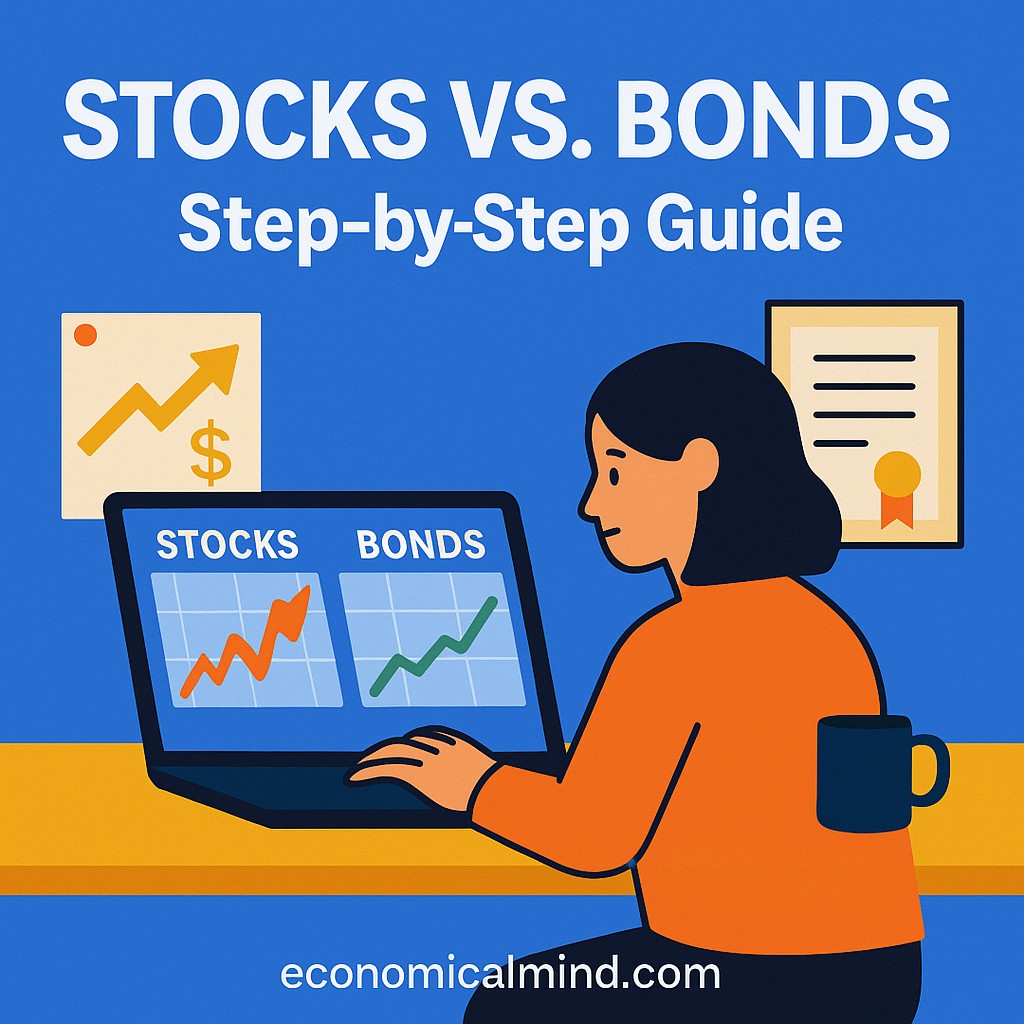
Why Understanding Stocks and Bonds Matters
If you’re new to investing, one of the first decisions you’ll face is whether to buy stocks, bonds, or a mix of both.
These two asset types are the building blocks of nearly every investment portfolio — but they serve very different purposes.
Knowing how they work helps you balance risk and reward, build wealth strategically, and make smarter financial decisions.
Step 1: Understand What Stocks Are
When you buy stocks, you’re purchasing ownership in a company.
That means you share in its profits (through dividends) and its potential growth (through price increases).
- Goal: Long-term growth and higher returns.
- Risk: Market volatility — prices can fluctuate daily.
- Reward: Potentially higher profits over time.
Example:
If you own 10 shares of Apple, you own a small portion of Apple itself — and benefit as its stock price rises or it pays dividends.
Step 2: Understand What Bonds Are
Bonds are essentially loans you give to governments or corporations.
When you buy a bond, you’re lending money in exchange for interest payments and the return of your principal at maturity.
- Goal: Stability and income.
- Risk: Lower than stocks, but vulnerable to inflation and interest rate changes.
- Reward: Predictable, steady returns over time.
Example:
If you buy a $1,000 government bond at 4% interest, you’ll earn $40 per year until the bond matures — then get your $1,000 back.
Step 3: Compare Risk and Return
The main difference between stocks and bonds is risk vs. reward.
| Asset Type | Typical Risk | Average Long-Term Return | Ideal For |
|---|---|---|---|
| Stocks | High | 7–10% per year | Growth-focused investors |
| Bonds | Low to Moderate | 2–5% per year | Stability and income seekers |
The higher return of stocks comes with more volatility. Bonds, meanwhile, help smooth out your portfolio during market downturns.
Step 4: Learn How They Work Together
Stocks and bonds complement each other beautifully in a diversified portfolio.
When stocks drop, bonds often hold steady or rise — helping protect your total wealth.
Typical allocation examples:
- Young investors: 80% stocks, 20% bonds
- Middle-aged investors: 60% stocks, 40% bonds
- Retirees: 40% stocks, 60% bonds
The right mix depends on your age, goals, and risk tolerance.
Step 5: Understand How to Buy Each
You can invest in both through:
- Brokerage accounts (Fidelity, Vanguard, Charles Schwab)
- Robo-advisors (Betterment, Wealthfront)
- ETFs or mutual funds that track stock or bond indexes
Popular choices:
- Stocks: Vanguard Total Stock Market ETF (VTI)
- Bonds: iShares Core U.S. Aggregate Bond ETF (AGG)
Starting with index funds is an easy, low-cost way to gain exposure to both.
Step 6: Rebalance Regularly
Over time, your investments will drift from your target mix as markets move.
For example, if stocks perform well, they may grow to 70% of your portfolio even if you started with 60%.
Rebalancing means selling a bit of what’s grown too much and buying what’s fallen behind — restoring your original balance.
Doing this once or twice per year keeps your risk level consistent.
Step 7: Think Long-Term
Short-term market swings can be stressful, but both stocks and bonds reward long-term investors.
Even with ups and downs, staying invested consistently beats trying to time the market.
Pro tip: Automate your investing. Set up automatic contributions each month into your stock and bond funds — and let time do the heavy lifting.
Bonus Tip: Use the “Age Rule” as a Simple Guide
A classic rule of thumb:
Your age ≈ the percentage of your portfolio that should be in bonds.
Example:
If you’re 30, you might hold 70% stocks / 30% bonds.
If you’re 60, shift to 40% stocks / 60% bonds for more stability.
It’s a simple way to balance risk as you move through life.
Final Thoughts
Both stocks and bonds play vital roles in your financial future.
Stocks grow your wealth over time, while bonds protect it during uncertain markets.
By understanding how they work and maintaining a balanced mix, you can create a portfolio that fits your goals — and keeps you on track for long-term success.
